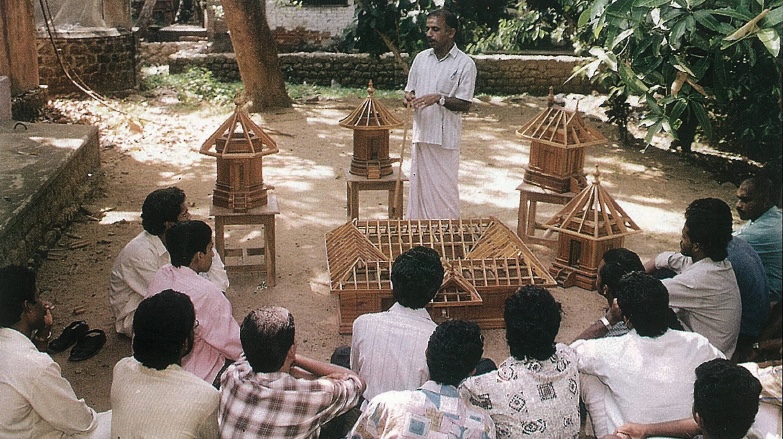By Vrindavanam S. Gopalakrishnan
Keralite Hindus are coming to a renewed appreciation of traditions once branded as primitive, obsolete and superstitious. Ayurvedic medicine, astrology, yoga and Hindu sacred arts have enjoyed revived interest. But in the process of moderizing India’s education system, many traditional training schools were shut down and skilled practitioners became scarce, especially in the sacred arts.
In Kerala, the science of temple construction, vastuvidya, and the related art of mural painting were pushed to the brink of extinction by the policies of the communist government and by challenges from non-Hindu philosophies. But even diehard communists here never completely abandoned their ancestors’ affection for temples, and with the fall of communism in the Soviet Union, some have openly returned to Hindu ways. While people are proud of the modern buildings, they also realize that they don’t possess that magical link between building, nature and the Divine which is present in the exquisite temples, palaces and residences built in the past.
In response to this need, the Kerala state government archaeological department set up the Vastuvidya Gurukulam at Aranmula, on the banks of holy river Pamba, famed for the yearly Onam festival’s snake-boat race. The school is charged with training designers and builders as well as experts in the mural painting known as sudhacitra, which adorns the walls of many Kerala temples.
Two faculty members, Dr. A. Achyuthan and Balagopal T.S. Prabhu, explained the college’s approach to design. “Vastu in its broadest meaning covers the four categories of earth, buildings, vehicles and furniture. Of these, we consider earth as two dimensional, whereas the others have three dimensional forms. In either case, the design will stipulate basic shape, size and orientation.” According to them, the “principles of vastuvidya are to be viewed as a building grammar.” While the temple architects of Tamil Nadu must master stone, here in Kerala wood is the building material of choice, and the school faculty includes master carpenters.
The application of vastuvidya principles in modern buildings will impact the planning of the site, orientation of the buildings, access to the plot and the building, shape, size and form of the buildings, orientation and dimensions of rooms, dimension of openings and the proportioning of each element. The principles are invoked so as to evolve designs satisfying both the modern building code requirements and the canons of vastuvidya.
Another department of the school teaches mural painting, sudhacitra, an art form which nearly went extinct. The method is unusual and like the one used for the murals of Ajanta caves. A mortar base of burnt shell, sand, jaggery, banana and sugar cane juice is first applied; then, to repel insects, a coat of finely ground shell and sand in wood apple and neem juices is applied with a brush of the champaka tree. A similar paste mixed with fresh coconut water is used to fix the finished art. The method is similar to what is called dry fresco in Europe, as the paints are applied to a dry surface, not wet plaster as in true fresco.
Students are taught how to make their own pigments from mineral sources such as ores, soils and carbon black. These are tedious to prepare, but store well and last longer in the mural. They also learn to make plant pigments, which must be used immediately. Western painting theory considers red, blue and yellow as primary colors, whereas traditional Indian painting is based on five primary colors–white, yellow, red, green and black. These five pure colors are considered to be associated with the five elements: earth, water, fire, air and ether, or akasha.
Irrespective of religious allegiance, people seek the school’s guidance in constructing residential homes and places of worship. Assistance has been provided for 590 residential buildings and 55 places of worship since the school’s founding in 1993. Now modern engineers, architects and artists undergo training here to supplement their contemporary methods with ancient wisdom.
